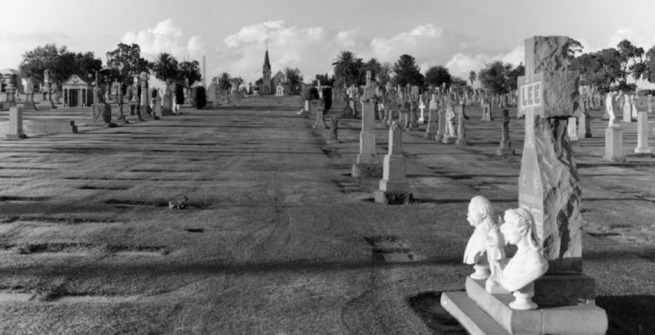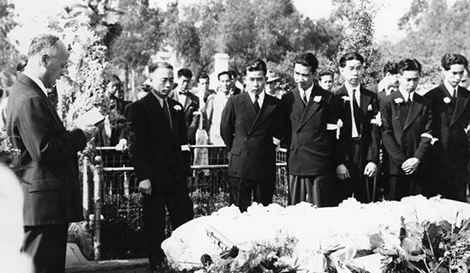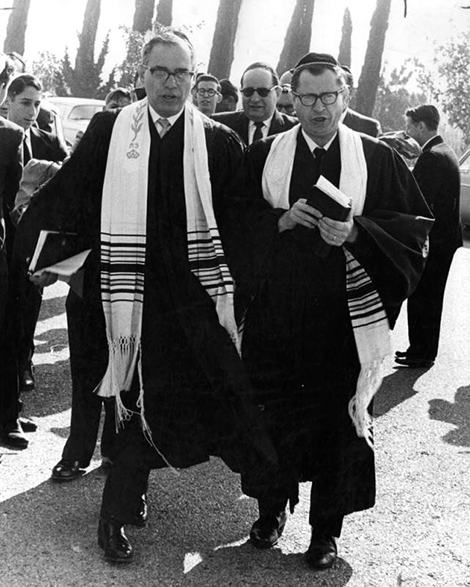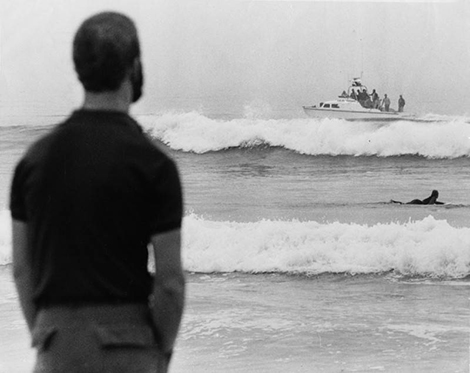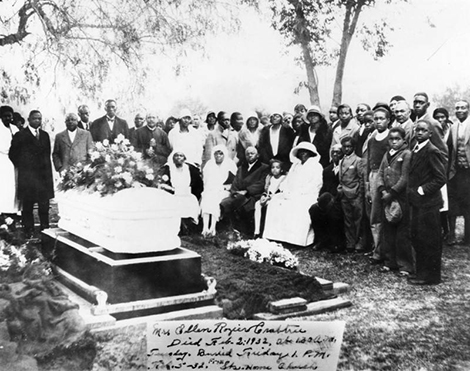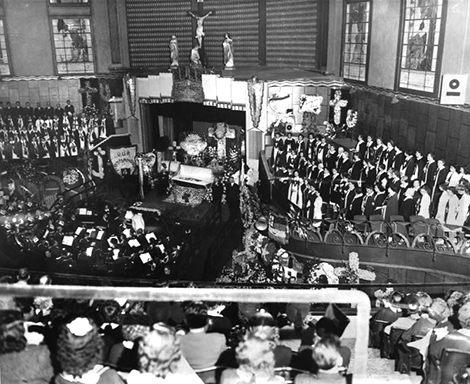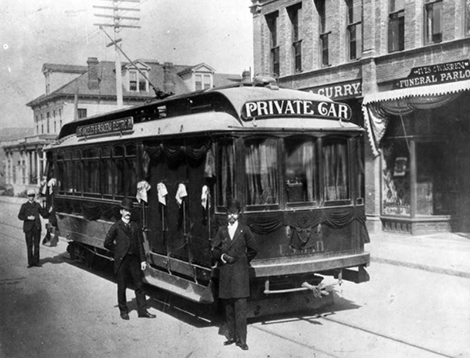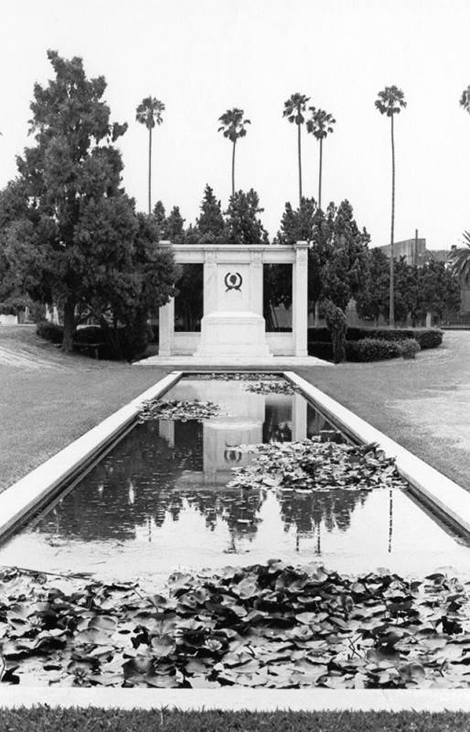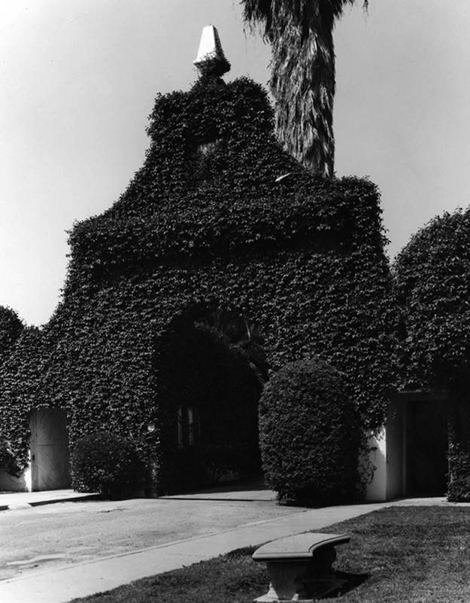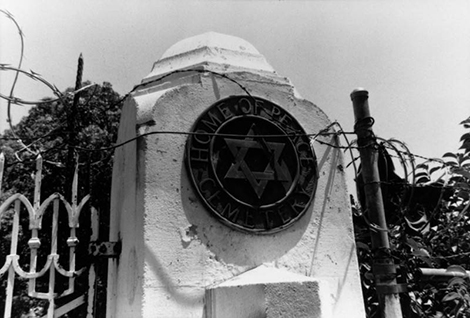Southern Californians have panache. From the clothes they wear to the dishes they cook to the homes they make, they create their own style—often a mixture of tradition and innovation—and show it proudly. This flair for living does not stop once they stop living. As you can see from the photo archives of the Los Angeles Public Library, Angelenos leave this earthly realm and go to a final resting place with as much elegance or flamboyance as they had in life.
It seems that residents of L.A. are always ready for their close-up. A beautiful headshot of a recently deceased gentleman adorns his gravesite in a section of a Southern California cemetery serving the Chinese community (with all tombstone writing in Chinese).
While Southern Californians embrace the latest fashion in dress and style, cultural traditions are still important. A burial service for two Chinese-Americans is held at a cemetery in Southern California. As white is symbolic of death in East Asian cultures, the men attending this funeral wear white armbands over their dark suits.
At Eden Memorial Park Cemetery in Mission Hills, Rabbi Aaron Wise and Cantor Allan Michelson lead a procession bringing religious books (Tefillin) and religious objects (prayer shawls, for example) for the Sheymot burial. This type of burial is rare and occurs only when religious objects can no longer be used.
The Pacific Ocean is the final resting place of one who loved the water and endeavored to keep all beachgoers safe. A boat scatters the ashes of a lifeguard in the waters off of Santa Monica beach while surfers look on.
Family and friends, from small children to senior citizens, gather for a graveyard funeral service honoring Ellen Rozier Crabtree and pose for a memorial photo.
A man dances the Adewa (also known as Adowa and Adzewa), a traditional African dance, at the funeral of W.K. Anin, the father of Chief Nana Kofi Anin, a Ghanaian American. The dancer is wearing a costume of kente cloth, a silk and cotton fabric native to the Akan ethnic group of Ghana. The funeral is being held in the Crenshaw District of Los Angeles.
Here we see family members pouring liquids to invoke ancestral spirits, an important prayer tradition performed at traditional Ghanaian funerals.
Aimee Semple McPherson, the evangelist who founded Angeles Temple, broadcast sermons over her own radio station, and donated many hours and dollars to Southern California charities, was put to rest in October of 1944. Her funeral was attended by thousands of mourners, many who traveled great distances to pay their respects in person.
Francis Herman Pencovic was born in San Francisco in 1911. In April of 1948, he announced that he was the new messiah and claimed to have led rocket ships to Earth from an extinct planet. He founded the WKFL (Wisdom, Knowledge, Faith, and Love) Fountain of the World cult in Simi Valley and changed his name to Krishna Venta. His group fought wildfires, fed the homeless, and gained national attention in 1949 when they were the first to offer aid to survivors of a commercial airline crash in Simi Valley. Krishna Venta was killed in a bombing carried out by two disgruntled former members of his church. Here we see his funeral in Chatsworth, California, attended by his faithful followers. (The cult ceased to exist in the mid-1970s.)
Stately and elegant, Moritz-Harrell Funeral Home was built in classic Spanish style on West Whittier Boulevard in Montebello, California. The building still houses a funeral home today.
For convenience and comfort, the Ives & Warren Funeral Parlor in Pasadena provided private transportation via streetcar for funeral attendees.
Douglas Fairbanks, Sr.—the swashbuckling actor who portrayed Robin Hood, Don Juan, and Zorro in silent films—died on December 12, 1939, of a heart attack. His funeral was held at the Wee Kirk o’ The Heather Chapel on the grounds of Forest Lawn in Glendale. His remains were temporarily interred in Forest Lawn Glendale’s Great Mausoleum while his widow, (Sylvia, Lady Ashley), had a marble monument with a raised tomb built at Hollywood Cemetery (now known as Hollywood Forever). Sylvia moved her late husband’s remains to this spot in October of 1941.
Wee Kirk o’ The Heather Chapel, a reproduction of a 17th Century church in Glencairn, Scotland, is in the forefront of this photo. The tower in the background was the Tower of Legends which was demolished in 1948.
Pictured here is the Great Mausoleum at Forest Lawn Cemetery in Glendale. Douglas Fairbanks Sr. was originally interred here.
Here is the raised tomb at Hollywood Forever Cemetery that is the final resting place of Douglas Fairbanks, Sr.
Hollywood Cemetery (later known as Hollywood Memorial Park and then renamed Hollywood Forever in 1998) was built in 1899 on 100 acres. By 1920, 40 acres at the south end of the cemetery had been sold to Paramount Studios. Many prominent people from the entertainment field are interred on the grounds—Rudolph Valentino, Cecil B. DeMille, Fay Wray, Jayne Mansfield, Tyrone Power—as well as others including gangster Bugsy Siegel, L.A.P.D. chief Tom Reddin, and Griffith J. Griffith, donor and namesake of Griffith Park.
The entrance to the Hollywood Cemetery (now known as Hollywood Forever Cemetery) projects a collegiate air with its ivy-covered arch.
Forest Lawn Memorial Park has several locations throughout Southern California. Forest Lawn in the Hollywood Hills boasts a beautiful mosaic depicting events from the history of the United States. Here we see a Veteran’s Day event (which included a sacred torch rite performed by the American Legion) being held shortly after completion of the mosaic.
The Home of Peace Cemetery in East Los Angeles was created on 35 acres of land donated by Kaspare Cohn, a businessman who played a pivotal role in the development of the City of Los Angeles and also had a major role in developing Jewish religious organizations in the region. When the cemetery was being constructed, Cohn negotiated an agreement with the Los Angeles Railway Company to extend a street car line to the cemetery, making the graveyard more accessible.
The original Calvary Catholic Cemetery (most commonly referred to as Old Calvary Cemetery but also known as Buena Vista Street Cemetery) was built on the site now occupied by Cathedral High School. Many prominent Los Angelinos are buried there, including General Andres Pico, the first-generation Californio who fought in the Battle of San Pasqual during the Mexican-American War, signed the Treaty of Cahuenga, and became a California State Assemblyman. The cemetery showcased the diversity of settlers in Los Angeles, boasting tombstones written in Spanish, English, Italian, French, and German.
Here we see a family plot at the Old Calvary Cemetery.
The New Calvary Catholic Cemetery, located at 4201 Whittier Boulevard in East Los Angeles, covers 137 acres and is owned by the Archdiocese of Los Angeles. It is the final resting place of many celebrities and dignitaries including oil magnates Edward Doheny and Harry F. Sinclair, Archbishop of Los Angeles Timothy Manning, boxer Jose Yarba (Mexican Joe Rivers), musician Ferdinand “Jelly Roll” Morton, and thespians Ethel Barrymore, Lionel Barrymore, Ramon Novarro, Irene Dunne, Lou Costello, and Pola Negri.
A faithful horse receives a proper funeral with a bugler playing reveille, a horsewoman bringing a wreath, and a crowd paying their respects.
Written by Annie Murphy. Originally published on the Photo Friends Blog July 30, 2019.
